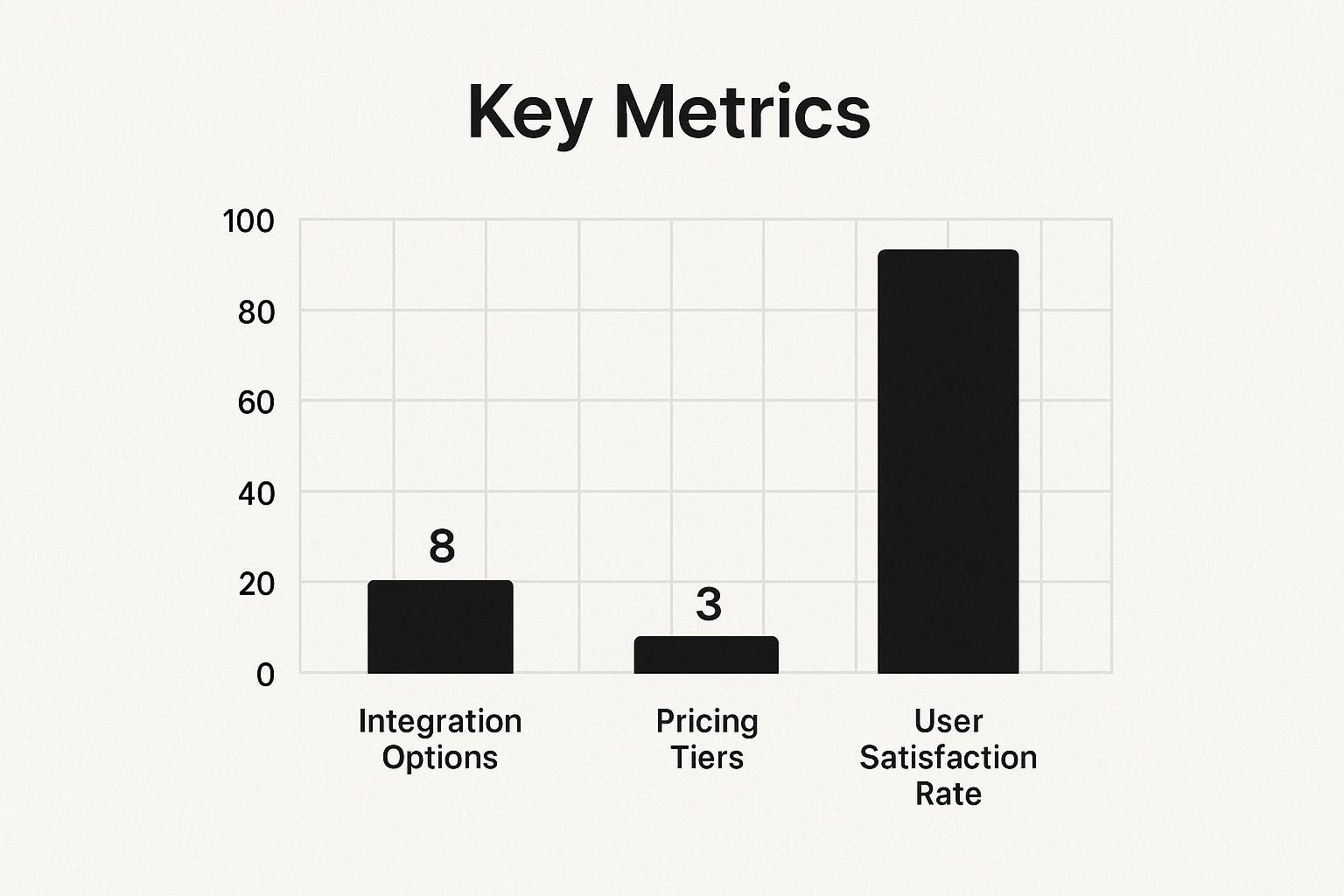Why Most Businesses Fail at Tracking Their Most Valuable Leads

Many businesses prioritize marketing channels like paid advertising and SEO but often neglect a critical component: referral tracking. Overlooking referrals can lead to a significant undervaluation of word-of-mouth marketing. Consequently, companies may misallocate resources and miss opportunities to capitalize on valuable leads.
Consider a SaaS company investing heavily in paid ads, seemingly generating a substantial portion of new customers. Without proper referral tracking, this company might not realize that many of these paid customers were initially referred by someone they know. This misattribution could lead to overspending on ads while neglecting the potential of a structured referral program.
Furthermore, failing to track referrals obscures the true customer acquisition cost (CAC). If referrals drive substantial new business but aren't accounted for, the calculated CAC will be inflated. This leads to inaccurate financial projections and potentially hinders growth. This lack of clarity prevents informed decisions about marketing budgets and overall strategy.
This is particularly concerning given the high trust associated with referrals. A remarkable 84% of people across 58 countries trust recommendations from friends and family more than any other source. This high level of trust highlights the importance of word-of-mouth referrals, which can significantly influence purchasing decisions in both B2B and B2C contexts. For example, 86% of B2B purchasing decisions are influenced by word-of-mouth, indicating that effective referral tracking is crucial for leveraging these recommendations. More detailed statistics can be found here: https://viral-loops.com/referral-marketing/statistics
The Impact of Untracked Referrals
The consequences of not tracking referrals extend beyond budget misallocation and skewed CAC calculations. It also impacts the ability to optimize the customer journey. Understanding how referrals enter the sales funnel allows businesses to tailor their onboarding process and messaging for these high-value customers.
Untracked referrals also hinder the development of effective referral programs. Without data on successful referrals and their motivations, businesses are left guessing when it comes to incentivizing and scaling their referral efforts. This represents a missed opportunity that could significantly limit growth.
In conclusion, tracking referrals is not simply about counting leads. It's about understanding the full impact of word-of-mouth marketing. By implementing effective tracking systems, businesses gain a competitive advantage, optimize marketing strategies, and unlock the full potential of their most valuable leads.
Choosing the Right Tracking Tools Without Wasting Your Budget
So, you understand the importance of tracking referrals. Now, how do you actually implement a system without overspending? Choosing the right tools is critical. This means understanding your specific needs and finding solutions that fit them without paying for features you won't use. There's no single perfect answer; the best approach depends on your business model, size, and budget.
Different Tracking Methods for Different Needs
There are several ways to track referrals, each with its own advantages and disadvantages.
CRM Systems (Customer Relationship Management): Many CRMs offer built-in referral tracking. This is a convenient starting point if you already use a CRM. Systems like Salesforce and HubSpot allow you to tag leads and track their origins, including referrals. However, the available features vary between systems, and some may lack more advanced referral tracking capabilities.
Dedicated Referral Platforms: These specialized platforms offer robust tracking features, including automated referral code generation, reward payouts, and detailed analytics. While comprehensive, they often come with a higher price tag.
Custom Solutions: For businesses with very specific needs, custom-built solutions offer maximum flexibility. This could involve developing in-house tools or integrating with your current analytics platforms. However, custom solutions require technical expertise and can be expensive to build and maintain.
Evaluating Your Options and Making the Right Choice
Choosing the right tool begins with understanding your needs. Consider these key factors:
Integration Capabilities: Does the tool integrate with your existing software? Can it connect with your email marketing platform, CRM, and analytics dashboard? Seamless integration is vital for a streamlined workflow and prevents data from being isolated in different systems.
Attribution Models: Does the tool support different attribution models? Looking beyond simple last-click attribution to models like first-touch, linear, or time-decay can give you a more complete picture of the customer journey and the impact of referrals. Explore different attribution models in our guide on different types of affiliate marketing.
Scalability: Can the tool grow with your business as your referral program expands? Choose a solution that can handle increasing data and transactions without performance issues.
Pricing vs. Value: Finding the Sweet Spot
Budget is always a consideration, particularly for startups and small businesses. But focusing only on price can be short-sighted. Weigh the cost against the value. A cheaper tool might lack crucial features, while a pricey option could include unnecessary functionalities. For example, the healthcare sector illustrates this balancing act. The global patient referral management software market, valued at USD 6.98 billion in 2021, is projected to reach USD 35.9 billion by 2030. This growth demonstrates the rising importance of efficient referral tracking across industries. More detailed statistics are available here: https://www.grandviewresearch.com/industry-analysis/patient-referral-management-software-market-report.
The following data chart illustrates the projected market growth of referral tracking solutions.

This bar chart shows the substantial year-over-year growth expected through 2030. The key takeaway is that while cost is a factor, the value of effective referral tracking is increasingly recognized.
The following table provides a comparison of several popular referral tracking software solutions.
Top Referral Tracking Software Comparison A detailed comparison of leading referral tracking solutions based on key features, pricing, and business size suitability
| Software Name | Key Features | Price Range | Best For | Integration Capabilities |
|---|---|---|---|---|
| Referral Rock | Automated referral program management, reward payouts, detailed analytics | $299-$1499/month | Medium to large businesses | Integrates with popular CRM and marketing automation platforms |
| Mention Me | Referral program design, multi-channel tracking, advanced analytics | Custom pricing | Ecommerce and subscription businesses | Integrates with major ecommerce platforms and CRM systems |
| Talkable | Personalized referral experiences, fraud detection, real-time reporting | Custom pricing | Enterprise-level businesses | Integrates with leading marketing and sales tools |
| Friendbuy | Customizable referral widgets, A/B testing, robust analytics | $249-$999/month | Small to medium businesses | Integrates with popular email marketing and ecommerce platforms |
| Buyapowa | Scalable referral programs, social sharing, gamification features | Custom pricing | Large businesses with complex referral needs | Integrates with enterprise-level marketing and CRM systems |
This table summarizes the key features, pricing, and ideal business size for each platform. Consider these factors in relation to your specific needs when choosing a solution.
By carefully evaluating your needs, exploring available options, and focusing on value, you can choose the best referral tracking tool without unnecessary expense.
Building Your Referral Tracking System From the Ground Up

Stop relying on guesswork. Understanding where your most valuable leads originate is crucial for growth. A robust referral tracking system is essential for achieving this. Instead of hoping referrals magically appear in your analytics, take proactive steps to capture this data. This section will guide you through building a system to accurately measure your word-of-mouth business.
Generating Unique Tracking Codes and Implementing UTM Parameters
One of the most effective methods for tracking referrals is using unique tracking codes. These codes, often embedded in URLs, pinpoint the specific source of each referral. For example, when partnering with an influencer, create a unique code just for them. When a conversion occurs from their unique link, you’ll know exactly where the referral originated.
Using UTM (Urchin Tracking Module) parameters provides even deeper insights into referral traffic. UTM parameters are tags added to a URL, providing details about the traffic source, medium, and campaign. This allows for segmentation of referral data and helps you understand which campaigns perform best.
Integrating Referral Data With Your Existing Tools
Integrating your tracking data with existing tools is vital for a truly effective referral tracking system. Connect your tracking data with your CRM (Customer Relationship Management), marketing automation platform, and analytics dashboard. This integration reveals the complete customer journey, from the initial referral to conversion and beyond.
For instance, CRM integration helps identify which referral sources produce the highest-value customers. This data can then inform your future marketing and partnership strategies. You might be interested in: How to master referral programs with templates.
Avoiding Common Pitfalls in Referral Tracking
Several common mistakes can hinder your referral tracking system. Inconsistent implementation of tracking codes is a major one. Ensure all referral links use the correct unique codes and UTM parameters.
Another frequent oversight is neglecting offline referrals. While digital tracking is important, don't forget referrals from phone calls, in-person meetings, or other offline channels. Implement a system for capturing these, such as a dedicated field in your CRM or a standardized intake form.
Tracking Across Different Channels
Your referral tracking system should capture referrals from all channels, including digital, social platforms, and even offline conversations. Different approaches are needed for each. Use unique links with tracking codes for digital channels. For social platforms, consider platform-specific tracking tools or UTM parameters. For offline conversations, train your team to consistently ask about referrals and accurately record the information.
Practical Implementation Checklist
Use this checklist to ensure your system captures every valuable referral:
- Generate Unique Tracking Codes: Create individual codes for each referral source.
- Implement UTM Parameters: Use UTM tags for granular data insights.
- Integrate with Existing Tools: Connect tracking data with your CRM and other platforms.
- Track Offline Referrals: Establish a system for capturing offline word-of-mouth referrals.
- Monitor and Adjust: Regularly review your data and adjust strategies accordingly.
By following these steps and implementing a comprehensive tracking system, you gain a clear understanding of how referrals contribute to your business growth. This allows for strategy optimization, rewarding your advocates, and maximizing the power of word-of-mouth marketing.
Cracking the Attribution Code: Beyond Last-Click Thinking
Many businesses rely on a last-click attribution model. This approach gives all credit for a conversion to the final click. However, it often undervalues the influence of referrals. Imagine a customer hears about your product from a friend (the referral), then sees your ad, and finally clicks an email link to purchase. Last-click attribution would credit the email, ignoring the referral's crucial role in initiating the customer journey.
This is where more nuanced attribution models become essential.
Exploring Advanced Attribution Models for Referrals
For a more accurate view of referral influence, consider these alternative attribution models:
First-Touch Attribution: This model gives full credit to the first touchpoint. If a referral initiated the customer journey, this model highlights its importance in introducing the customer to your brand.
Linear Attribution: Credit is distributed evenly across all touchpoints. If a journey includes a referral, a paid ad, and an organic search, each receives equal credit.
Time-Decay Attribution: This model prioritizes touchpoints closest to the conversion while still acknowledging earlier influences like referrals. It emphasizes the interactions immediately preceding the purchase.
Algorithmic Attribution (Data-Driven): Using data and machine learning, this model determines each touchpoint's contribution. This provides a deeper understanding of how various marketing channels, including referrals, interact.
Tracking Direct and Indirect Referrals
Effective referral tracking means capturing both direct and indirect influences. Direct referrals, like those from a formal referral program with unique tracking links, are easily measurable. Indirect referrals, like recommendations from conversations or social media, are harder to quantify. Encouraging customers to share how they learned about your business can help capture these indirect referrals.
The increasing importance of referrals is reflected in market growth. The global referral management market, valued at USD 3.2 billion in 2022, is projected to reach USD 6.1 billion by 2027. This growth is fueled by technological advancements and increased adoption of referral management solutions. Learn more about the referral management market: Referral Management Market
Choosing the Right Attribution Framework
The ideal attribution model depends on your business model, technology, and customer journey complexity. A linear or time-decay model might suit businesses with longer sales cycles, while a first-touch model could be more insightful for shorter cycles. Experimentation and analysis are key to finding the most effective framework. By moving beyond last-click attribution, businesses can unlock the true potential of referral marketing, allowing for accurate measurement, optimized strategies, and ultimately, significant growth.
Measuring What Actually Matters in Referral Performance

Simply tracking the number of referrals isn't enough. To truly understand their impact, you need to analyze what those referrals mean for your bottom line. This involves measuring the right key performance indicators (KPIs) and building dashboards that offer actionable insights, not just surface-level numbers. This section explores how to properly evaluate referral program success and optimize your strategies for maximum ROI.
Identifying the KPIs That Drive Business Decisions
Different KPIs provide different perspectives on your referral program's performance. Some of the most critical include:
Referral Conversion Rate: This metric measures how effectively your referred visitors convert into paying customers. A high conversion rate indicates that your referral program is attracting highly qualified leads.
Customer Acquisition Cost (CAC) from Referrals: This KPI reveals the cost of acquiring a customer specifically through your referral program. Comparing this cost to the CAC from other marketing channels, like paid advertising or social media, helps you understand the relative cost-effectiveness of referrals.
Customer Lifetime Value (CLTV) of Referred Customers: This represents the total revenue you can expect from a referred customer throughout their entire relationship with your business. Often, referred customers demonstrate a higher CLTV than those acquired through other channels due to increased loyalty and engagement.
Referral Program ROI (Return on Investment): This crucial metric measures the overall profitability of your referral program. It’s calculated by dividing the total revenue generated by the program by the total cost. A positive ROI signifies a successful and profitable program.
Number of Referrals per Advocate: Tracking this KPI reveals how effective your brand advocates are at referring new customers. Identifying and understanding your high-performing advocates can provide valuable insights into what motivates successful referrals.
This isn't an exhaustive list, but it highlights key metrics that offer crucial insights into your referral program's health. For more strategies, consider reading articles on increasing affiliate sales, such as How to increase your affiliate sales.
Building Actionable Dashboards
Your dashboard should visualize these KPIs in a clear, concise manner. This allows you to quickly identify emerging trends, spot potential problems, and make informed decisions based on real-time data.
For instance, a sudden drop in the referral conversion rate might indicate an issue with your onboarding process or a decline in the quality of referred leads. Conversely, a rising CAC from referrals might suggest that your incentive structure has become too expensive.
To illustrate the core metrics used in evaluating a referral program's success, the following table provides a detailed breakdown.
Essential Referral Program Metrics: A comprehensive list of key performance indicators to track when evaluating referral program success
| Metric | Definition | Calculation Method | Target Range | Business Impact |
|---|---|---|---|---|
| Referral Conversion Rate | Percentage of referred visitors who convert into customers | (Number of referred conversions / Number of referred visitors) * 100 | Varies by industry, aim for higher than overall conversion rate | Indicates quality of referred leads and effectiveness of onboarding |
| Customer Acquisition Cost (CAC) from Referrals | Cost of acquiring a customer through referrals | (Total referral program costs / Number of referred customers) | Lower than other acquisition channels ideally | Shows cost-effectiveness of referral program |
| Customer Lifetime Value (CLTV) of Referred Customers | Total revenue expected from a referred customer | (Average purchase value * Average purchase frequency * Average customer lifespan) | Ideally higher than non-referred customers | Demonstrates long-term value of referred customers |
| Referral Program ROI | Return on investment of referral program | (Total referral revenue - Total referral program costs) / Total referral program costs | Positive ROI is the goal | Measures overall profitability of the program |
| Number of Referrals per Advocate | Average number of referrals generated by each advocate | (Total number of referrals / Number of advocates) | Higher indicates more active advocates | Helps identify and reward top performers |
This table outlines essential metrics, their definitions, calculation methods, target ranges, and their impact on your business. By regularly tracking and analyzing these metrics, you can gain invaluable insights into your referral program's performance and make data-driven decisions to optimize its effectiveness.
Optimizing Referral Strategies Based on Data
Successful businesses continuously monitor their referral program data and use the resulting insights to optimize their strategies. This might involve adjusting referral incentives, refining targeting parameters to reach the right audience, or improving the referral process itself to make it more seamless and user-friendly. For instance, if your data reveals that referred customers have a significantly higher CLTV, you might consider increasing your investment in the referral program to further capitalize on this valuable customer segment. By focusing on these key metrics and letting data inform your decisions, you can ensure your referral program becomes a powerful engine for sustainable business growth.
Industry-Specific Strategies That Actually Work
Tracking referrals effectively isn't a one-size-fits-all approach. What drives conversions for an e-commerce store might be entirely different for a B2B SaaS company. To truly understand how to track referrals, we need to delve into the nuances of different industries. This means adapting general referral principles to specific customer behaviors and regulatory environments.
SaaS: Leveraging Product Integrations and In-App Tracking
In the SaaS world, understanding user behavior within the application is paramount. This means integrating referral tracking directly into the product. Imagine a project management software like Asana where users can invite team members. By tracking these invitations and subsequent sign-ups, you can directly measure the impact of in-app referrals. Additionally, integrating with other platforms within the SaaS ecosystem can broaden your reach and simplify tracking processes.
Healthcare: Navigating Compliance and Prioritizing Patient Privacy
Healthcare presents unique challenges due to stringent regulations like HIPAA. While tracking referrals is essential for optimizing patient care coordination, maintaining patient privacy is non-negotiable. Successful healthcare organizations utilize anonymized data and secure platforms to track referrals while adhering to compliance requirements. For instance, a dental practice might track referral sources without revealing specific patient information, focusing instead on understanding which specialists or channels drive the most new patients. As noted in a blog post by Open Dental, tracking sources such as Facebook or Google can provide insights into how patients discover your practice (Open Dental Blog).
Financial Services: Building Trust and Measuring Long-Term Value
In financial services, trust is paramount. Referrals, often stemming from existing client relationships, carry significant weight. Tracking these referrals focuses on understanding which clients generate the most valuable new business. This could involve tracking assets under management or the lifetime value of referred clients. This focus on long-term value aligns with the industry's emphasis on building lasting relationships.
Professional Consulting: Attributing Value Across Complex Sales Cycles
Consulting firms often deal with long and complex sales cycles. Attributing value to referrals in this context requires a sophisticated approach. This may involve multi-touch attribution models, considering both the initial referral and subsequent interactions that lead to closing a deal. For example, a management consulting firm might use a time-decay model, giving partial credit to a referral that occurred months before the final contract signing, while also acknowledging the contributions of other marketing efforts.
Customizing Your Approach Based on Customer Journey and Decision-Making
Regardless of industry, understanding the customer journey is key to effective referral tracking. This means mapping out the various touchpoints, from the initial referral to conversion, and identifying the specific metrics that matter most for your business. In e-commerce, this might involve tracking click-through rates and purchase values, while in B2B, it could focus on lead qualification and deal closing rates. The key is to align your tracking methods with how your target audience makes decisions.
Refgrow empowers SaaS businesses to leverage the power of referrals. By seamlessly integrating affiliate tracking within your product, Refgrow simplifies the entire process from referral generation to reward payout. Eliminate external platforms, automate your tracking, and unlock the growth potential of your user base. Learn more about how Refgrow can help you track referrals and maximize your ROI: https://refgrow.com

